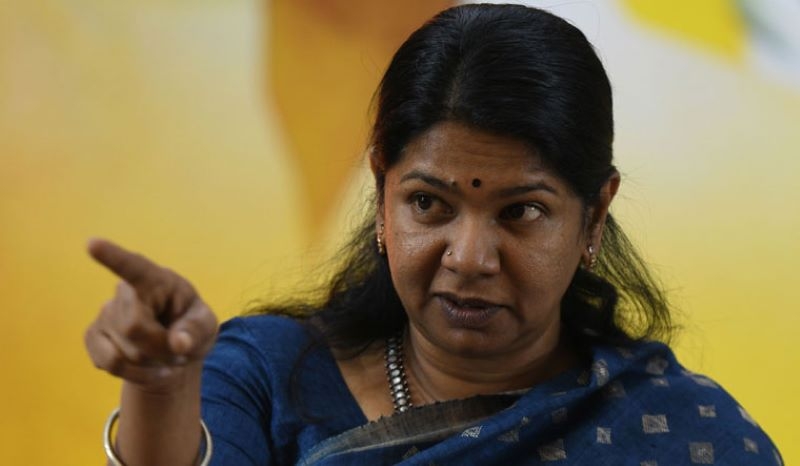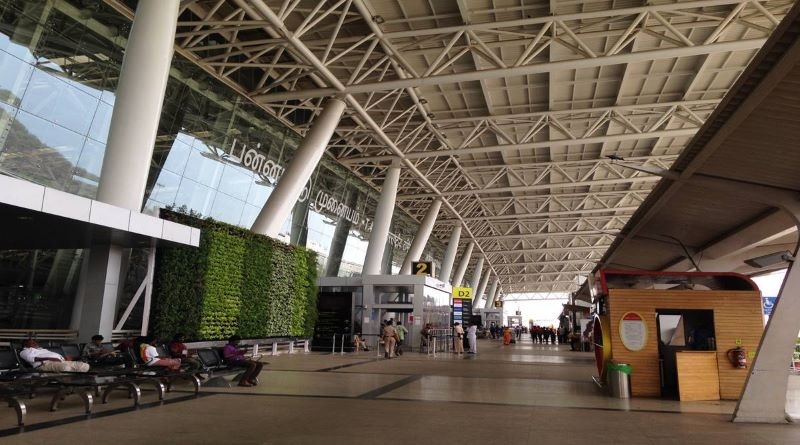Cultural Narcissism – Contra National Unity and Integration

Ms. Kanimozhi, DMK MP
Of course, the need for a nuanced debate is more than never before what with its ugly faces manifesting all over again as a political ploy to mobilize and polarize voters under the regional party flag umbrellas, particularly in Tamil Nadu.
Recently, Ms. Kanimozhi, daughter of M. Karunanidhi (an atheist) from his third wife, and DMK Party Member of Parliament in Lok Sabha have stirred the hornet’s nest by her recent rhetoric against the imposition of Hindi.
At the outset, let me highlight Ms. Kanimozhi’s background. She was a student of Presentation Convent, Church Park in Chennai, and later did her master's degree in economics at Ethiraj College for Women from Madras University. She has been married twice; firstly in 1989 to Athiban Bose, a businessman from Sivakasi, and then to G. Aravindan, a Singapore-based Tamil writer, in 1997. She has a son named Aditya Aravindan.
Before entering politics, Ms. Kanimozhi had a stint in journalism as sub-editor in The Hindu, editor in Kungumam (a Tamil Weekly magazine) and editor in Tamil Murasu (a Singapore-based Tamil Newspaper).
Kanimozhi functions as the chief of the DMK's wing for Art, Literature, and Rationalism and is seen as her father's "literary heir".
Ms. Kanimozhi is no stranger to creating political controversies with a record of criminal charges leveled against her to include particularly the 2G scam.
With the Tamil Nadu State Assembly elections scheduled to be held in February 2021, naturally, she would exploit every single opportunity to invoke her penchant for “Cultural Narcissism” with utter disregard for its far-reaching adverse impact on promoting, advancing and consolidating national unity and integrity.
Recently, she complained that a woman officer of the paramilitary agency at the Chennai airport had asked her if she was Indian for not speaking in Hindi. Quick to seize the opportunity, Ms. Kanimozhi told The Hindu that “It would not have been an issue if the incident took place in Delhi. Surprisingly it happened at Chennai airport.”

More importantly, she is on record criticizing that “More than not knowing Hindi, the issue of equating Hindi with nationalism is "shameful" and it edged out all other languages in the country in determining one's identity.”
Followed on 20 August 2020, Ms. Kanimozhi, who demanded the suspension of Vaidya Rajesh Kotecha, Secretary of the Ministry of Ayush, for allegedly asking non-Hindi speaking doctors to leave the training session. She termed it as “volumes about the Hindi domination being imposed. This is highly condemnable."
Having been a High School student in Madras during 1949 to 1954, commissioned and served in the Madras Regiment, and on the faculty of Staff College (1983-1985 and 1993-1993), I had followed the developments in Tamil Nadu including Periyar, E V Ramasamy (1879-1973), anti-Aryan influenced Hinduism or Brahmanism, more than the faiths of Islam, Buddhism and Christianity. Let me highlight that the language issue in Tamil Nadu predates 1947.
Ipso facto, the anti-Hindi agitation of 1965 was spearheaded by the DMK that enabled the Party to give drubbing to the Congress Party in 1967 elections. The rest is history.
Recently, M K Stalin, the DMK President upped the ante: "Imposing Hindi on Tamil Nadu would be similar to throwing stones at a beehive." The ruling AIADMK, which fought the recent Parliamentary elections in alliance with the BJP, too made it clear that it will continue with the existing Two-Language Policy in the state.
Contrary to popular belief, Tamil Nadu today does not stop anyone from learning Hindi. There are Hindi Prachar Sabhas across the state. Tamils going to North India or other states learn the local language and speak it fluently than many of their counterparts in the rest of the country. There are many Tamil immigrants permanently settled in Megapolises like Mumbai, Delhi, Hyderabad, and Bangalore, who are very well versed with Hindi and also local languages.
The DMK made an attempt to seize the opportunity when the draft of National Policy on Education, 2019, was circulated by the central government. However, the BJP-led NDA swiftly got into a damage control mode. Cabinet ministers of Tamil origin, Dr. S Jaishankar, and Nirmala Sitharaman, tweeted in Tamil saying that it wasn’t the intention of the central government to impose any language on any state, and it is just a draft policy to solicit public opinion. HRD Minister Ramesh Pokhriyal termed it a misunderstanding. Soon, the draft policy was amended to remove the mandatory Hindi clause.
Let me highlight that there is no national language in modern India. But there are 22 official languages to include Hindi, Tamil, Telugu, Marathi, Assamese, and Punjabi, etc.
Least realized the Hindi language is based on “Devanagiri Script” that used to write Sanskrit - Brahmic family of scripts of India, Nepal, Tibet, and Southeast Asia. Marathi, Hindi and its dialects, Konkani, Telugu, Kannada, and other languages have over 70 to 80% of words drawn from Sanskrit. For example, words like Athya Adikam, Avadhi, Anthargatham, Bhasha, Samayam, Samanyamu, etc., are common in Telugu.
Be that as it may, there is a need to develop an understanding of the definition and meaning of culture. Language forms only constitute one facet of culture. Culture is an umbrella term to include: religion, caste, values, behavior, dress, food habits, beliefs, arts, laws, customs, manners, and habits of the individuals in a particular group and their demeanor in a situation. As per experts, humans acquire culture through the learning processes of enculturation and socialization, which is shown by the diversity of cultures across societies.
As per eminent experts of anthropology, culture change is inevitable. In reality, culture is always evolving. Culture can never rigidly remain static or revert to status quo ante to a primordial state. When new things are added to material culture every day, naturally they affect nonmaterial culture also. After all, culture changes open up new ways of living, and when new ideas enter a culture.
Stating the obvious, technology is having a tremendous impact on people. Cell phones have largely replaced public phones. The E-mail has replaced letters. They are reshaping values and visions of the ‘self” – more materialistic and self-centric.
Ramón Panikkar identified 29 ways in which cultural change is sweeping mankind including growth, development, evolution, involution, renovation, re-conception, reform, innovation, revivalism, revolution, mutation, progress, diffusion, osmosis, borrowing, eclecticism, syncretism, modernization, indigenization, and transformation.
Cultures are internally affected by both forces encouraging change and forces resisting change. These forces are related to both social structures and natural events and are involved in the perpetuation of cultural ideas and practices within current structures, which themselves are subject to change.
Cultures change in a number of ways. The only way new cultural traits emerge is through the process of discovery and invention. Someone perceives a need and invents something to meet that need. Yet another way cultures change is through the process of acculturation. Acculturation is also the borrowing of traits.
Historically, India was known as the melting pot of civilizations that refers to the blending of cultures. Experts classify modern India as a “Pluralist” society. And, the process of cultural changes is taking place inevitably. The dominant culture picks and chooses those traits from the subordinate culture that it deems useful, i.e., diffusion. The subordinate culture is pressured to adopt the traits of the dominant culture. Another form of acculturation is called the Salad Bowl, or cultural pluralism. This occurs when people immigrate and keep as many original cultural traits as possible.
Religious communities today are accepting changes that have occurred within our culture. Technology delivers messages of spiritual uplift through the use of information technology at a rate faster than the speed of light. The sum total is technology has changed and is changing the face of society from all elements of culture.
If so, Ms. Kanimozhi and M K Stalin of the DMK must admit that Tamil society too cannot resist changes in various facets of culture. With the Information Technology revolution sweeping mankind, all societies are experiencing accelerated changes in the full spectrum of traditional/conservative culture.
If genuinely interested in advancing the interests of Tamil people, Ms. Kanimozhi and M K Stalin of the DMK must encourage their cadres to adapt themselves to culture changes instead of stoking flames.
Let me cite a few examples of how the Tamil people have adapted themselves to cultural changes particularly in the dress habits. Today, young girls even in villages wear the “jeans” or “Salwar Kamiz” instead of the traditional “Long Skirt and Blouse” until they attain maturity age. The traditional “Half Sari” is no more the norm. Even Ms. Kanimozhi is seen in “Salwar Kamiz”.
Many educational institutions in Tamil Nadu have their own dress codes – more liberal than 2-3 decades ago. Take a cue from Ms. Kamala Harris's adaptation to culture changes claiming the lineage of the traditional Tamil Brahmin lineage.
It is also quite absurd to expect all Tamil MPs to wear the traditional attire of “Dhoti” like P Chidambaram. So also, eat only “Rice and Sāmbhar” in the Parliament house cafeteria.
Next, Ms. Kanimozhi in her Rajya Sabha debut as MP has participated in many debates in “English” and not in “Tamil” language. Why? The Parliament allows its members the freedom to speak in their own language.
In the field of art, dance, and films, fusion is taking place. Even the traditional “Bharatnatyam” has undergone subtle changes in its traditional style. Speaking as a practicing artist, who has inherited that tradition from illustrious gurus, Malavika Sarukkai has been demonstrating the changes that influenced Bharatnatyam.
The Tamil society must be proud of the deep influence of Carnatic music on cinema what with legends like GNB, MK Thyagaraja Bhagavathar, and Ms. Subbulakshmi active on stage and on-screen.
The biggest influence, of course, was of the legendary Papanasam Sivan, who lived in Chennai. It is a well-known fact that A.R. Rahman uses either Carnatic or Hindustani bases in his compositions.
In sum, political leaders of the Dravidian parties must abandon myopic language-centric “cultural narcissism” as a means to achieve political ends of gaining and retaining power. Earlier they realize and appreciate that culture changes are inevitable due to modernization processes, the better it is for them and the Tamil society.
Instead of resisting culture changes for political benefits, they must promote blending Tamil society many facets of traditional culture with the rest of the pluralist and diverse societies of India. Instead of rigid opposition in pursuit of political gains, they must exploit the opportunities available in a democracy to spread the best facets of their culture in the rest of the country like the idly-dosa-chutney-sambar cuisine all over the world today or the blending of the Carnatic music in symphonies across the world.


